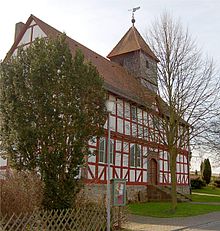Evangelical Church Carlsdorf
The Protestant Church is a listed church building in Carlsdorf , a district of Hofgeismar in the Kassel district ( Hesse ). It was built as a transverse church for settled Huguenots according to plans by Paul du Ry . It is a two-storey, structured half-timbered building with a shingled roof turret that fits into the surrounding residential development.
architecture
It is a two-storey, articulated half-timbered building with a shingled roof turret . This sits in the west on the ridge of the gable roof . As a half-timbered building, the church ties in with the regional architecture and not with southern French traditions.
The church in Carlsdorf is "the only transverse hall among the ... Huguenot and Waldensian churches in Hessen-Kassel."
The interior of the church is symmetrically structured. Two square wooden supports support the longitudinal girder. The pastor's pulpit and stand are on the south side. The Lord's Supper is in front of it. The gallery runs along the north and west walls.
Building history
The church was built in the first colony of French migrants in Hessen-Kassel between 1701 and 1704 according to plans by Paul du Ry, who also designed the floor plan of the village. The plans for the church date back to 1699, when the congregation asked Blaise Martin through their greben to be allowed to build a temple. Thereupon, in August, the responsible forestry office was instructed by the rulership to provide the necessary trunks, supplemented by a sovereign donation of 50 trunks in October 1699. An instruction from the Rentkammer of 100 Reichstalers supported the community's construction project, which itself received 100 talers wanted to contribute, but now had to bear all other construction costs. Because of their poverty, the Réfugiés had to hold collections for the church. In addition, Landgrave Karl von Hessen-Kassel approved a further 52 logs of timber.
The subjects of the offices of Grebenstein , Sababurg and Trendelburg had to perform tensioning services from August 1702 to get the slate for the church roof, so the shell was already completed by this time.
Two state collections, the last in 1704, enable the completion of the church, which was consecrated on October 19, 1704. This year can also be found on the sound cover of the pulpit .
portal
The richly carved and colored portal is provided with a French inscription, as the church was built as a Huguenot church. The inscription above the portal bears the year 1702 and is regarded as the date of the topping-out ceremony. She “praises the generous support” from the sovereign. On the left is the monogram of the sovereign C + L + Z + H, opposite the Hessian lion.
Bells
The landgrave donated two bells, one in August 1704, a smaller one in February 1705.
literature
- Georg Dehio: Handbook of the German art monuments, Hessen . Deutscher Kunstverlag, Munich 1966
Web links
Individual evidence
- ↑ Kathrin Ellwardt, Church building between Protestant ideals and absolutist rule, p. 30 f.
- ^ Kathrin Ellwardt, Church building between evangelical ideals and absolutist rule. The cross churches in the Hessian area from the Reformation century to the Seven Years' War. Dissertation Marburg 2000. Michael Imhof Verlag Petersberg 2004. ISBN 3-937251-34-0 , p. 231
- ^ Translation by Klaus Wicke, 300 years of Carlsdorf. On the history of the oldest Huguenot settlement in Hessen. In: ders, Carlsdorf 1686-1986. Festschrift for the 300th anniversary of the oldest Huguenot settlement in Hesse. Hofgeismar-Carlsdorf. Pp. 9-25, p. 20.
- ↑ Georg Dehio ; Edited by Magnus Backes: Hessen . In: Handbook of German Art Monuments . First volume. Deutscher Kunstverlag, Munich, Berlin 1966, p. 122 .
- ↑ Kathrin Ellwardt, Church building between Protestant ideals and absolutist rule, p. 231.
Coordinates: 51 ° 29 ′ 14 " N , 9 ° 25 ′ 38" E

